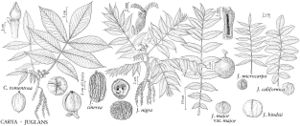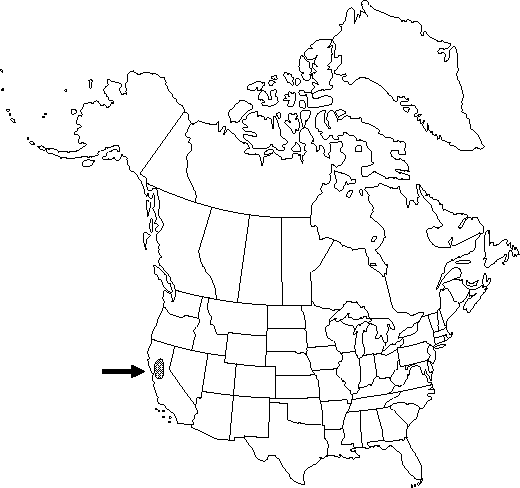Difference between revisions of "Juglans hindsii"
Univ. Calif. Agric. Exp. Sta. Bull. 203: 27. 1909.
FNA>Volume Importer |
imported>Volume Importer |
||
| (7 intermediate revisions by 2 users not shown) | |||
| Line 16: | Line 16: | ||
}}{{Treatment/ID/Special_status | }}{{Treatment/ID/Special_status | ||
|code=F | |code=F | ||
| − | |label= | + | |label=Illustrated |
}} | }} | ||
|basionyms= | |basionyms= | ||
| Line 22: | Line 22: | ||
|name=Juglans californica var. hindsii | |name=Juglans californica var. hindsii | ||
|authority=Jepson | |authority=Jepson | ||
| + | |rank=variety | ||
}} | }} | ||
|hierarchy=Juglandaceae;Juglans;Juglans hindsii | |hierarchy=Juglandaceae;Juglans;Juglans hindsii | ||
| Line 30: | Line 31: | ||
}}<!-- | }}<!-- | ||
| − | --><span class="statement" id="st- | + | --><span class="statement" id="st-undefined" data-properties=""><b>Trees,</b> 6-23 m. <b>Bark</b> light or medium gray, split into smooth or ± scaly plates. <b>Twigs</b> with distal edge of leaf scar shallowly to deeply notched, not bordered by well-defined band of pubescence; pith light brown. <b>Terminal</b> buds ellipsoid to oblong, flattened, 6-8 mm. <b>Leaves</b> 22-45 cm; petiole 3-8 cm. <b>Leaflets</b> 13-21, narrowly triangular to lanceolate, symmetric or weakly falcate, (5.6-)7.3-13 × (1-)1.9-2.8 cm, margins serrate, apex acuminate; surfaces abaxially glabrous or with sparse glands, sparse glands and few capitate-glandular hairs scattered along major veins, fasciculate hairs conspicuously tufted in axils of proximal veins, sometimes also on adjacent blade and edges of midrib, adaxially glabrous or with scattered scales, major veins glabrous or with sparse scattering of glands and few capitate-glandular hairs, without nonglandular hairs; terminal leaflet well developed. <b>Staminate</b> catkins 6-15 cm; stamens 20-40 per flower; pollen sacs 1-1.4 mm. <b>Fruits</b> 1-2, globose, 3.5-5 cm; nuts ovoid to ovoid-globose, 2.4-3.2 cm, smooth or nearly so or shallowly and indistinctly ridged or grooved.</span><!-- |
-->{{Treatment/Body | -->{{Treatment/Body | ||
| Line 38: | Line 39: | ||
|distribution=Calif. | |distribution=Calif. | ||
|discussion=<p>Of conservation concern.</p><!-- | |discussion=<p>Of conservation concern.</p><!-- | ||
| − | --><p>Before 1850, Juglans hindsii was restricted to a few locations (J. R. Griffin and W. B. Critchfield 1972). It has been widely used as a rootstock for grafting J. regia and has been planted extensively in many parts of California for this purpose. It is now naturalized in many areas where it apparently did not occur before the introduction of commercial walnut growing. Possibly some of these naturalized populations are introgressed with J. nigra, since spontaneous hybridization between J. hindsii and J. nigra has been reported in areas where both species have been planted. These hybrids are difficult to distinguish from J. hindsii unless fruit are present. Currently most commercial walnut orchards use hybrid rootstocks, usually J. hindsii × J. regia (G. H. McGranahan and P. B. Catlin 1987).</p> | + | --><p>Before 1850, <i>Juglans hindsii</i> was restricted to a few locations (J. R. Griffin and W. B. Critchfield 1972). It has been widely used as a rootstock for grafting J. regia and has been planted extensively in many parts of California for this purpose. It is now naturalized in many areas where it apparently did not occur before the introduction of commercial walnut growing. Possibly some of these naturalized populations are introgressed with <i>J. nigra</i>, since spontaneous hybridization between <i>J. hindsii</i> and <i>J. nigra</i> has been reported in areas where both species have been planted. These hybrids are difficult to distinguish from <i>J. hindsii</i> unless fruit are present. Currently most commercial walnut orchards use hybrid rootstocks, usually <i>J. hindsii</i> × J. regia (G. H. McGranahan and P. B. Catlin 1987).</p> |
|tables= | |tables= | ||
|references= | |references= | ||
| Line 47: | Line 48: | ||
-->{{#Taxon: | -->{{#Taxon: | ||
name=Juglans hindsii | name=Juglans hindsii | ||
| − | |||
|authority=Jepson ex R. E. Smith | |authority=Jepson ex R. E. Smith | ||
|rank=species | |rank=species | ||
| Line 61: | Line 61: | ||
|publication title=Univ. Calif. Agric. Exp. Sta. Bull. | |publication title=Univ. Calif. Agric. Exp. Sta. Bull. | ||
|publication year=1909 | |publication year=1909 | ||
| − | |special status=Conservation concern;Endemic; | + | |special status=Conservation concern;Endemic;Illustrated |
| − | |source xml=https:// | + | |source xml=https://bitbucket.org/aafc-mbb/fna-data-curation/src/2e0870ddd59836b60bcf96646a41e87ea5a5943a/coarse_grained_fna_xml/V3/V3_364.xml |
|genus=Juglans | |genus=Juglans | ||
|species=Juglans hindsii | |species=Juglans hindsii | ||
| − | |||
| − | |||
| − | |||
| − | |||
| − | |||
| − | |||
| − | |||
| − | |||
| − | |||
| − | |||
| − | |||
| − | |||
| − | |||
| − | |||
| − | |||
| − | |||
| − | |||
| − | |||
| − | |||
| − | |||
| − | |||
| − | |||
| − | |||
| − | |||
| − | |||
| − | |||
| − | |||
| − | |||
| − | |||
| − | |||
| − | |||
| − | |||
| − | |||
| − | |||
| − | |||
| − | |||
| − | |||
| − | |||
| − | |||
| − | |||
| − | |||
| − | |||
| − | |||
| − | |||
| − | |||
| − | |||
| − | |||
}}<!-- | }}<!-- | ||
-->[[Category:Treatment]][[Category:Juglans]] | -->[[Category:Treatment]][[Category:Juglans]] | ||
Latest revision as of 22:48, 5 November 2020
Trees, 6-23 m. Bark light or medium gray, split into smooth or ± scaly plates. Twigs with distal edge of leaf scar shallowly to deeply notched, not bordered by well-defined band of pubescence; pith light brown. Terminal buds ellipsoid to oblong, flattened, 6-8 mm. Leaves 22-45 cm; petiole 3-8 cm. Leaflets 13-21, narrowly triangular to lanceolate, symmetric or weakly falcate, (5.6-)7.3-13 × (1-)1.9-2.8 cm, margins serrate, apex acuminate; surfaces abaxially glabrous or with sparse glands, sparse glands and few capitate-glandular hairs scattered along major veins, fasciculate hairs conspicuously tufted in axils of proximal veins, sometimes also on adjacent blade and edges of midrib, adaxially glabrous or with scattered scales, major veins glabrous or with sparse scattering of glands and few capitate-glandular hairs, without nonglandular hairs; terminal leaflet well developed. Staminate catkins 6-15 cm; stamens 20-40 per flower; pollen sacs 1-1.4 mm. Fruits 1-2, globose, 3.5-5 cm; nuts ovoid to ovoid-globose, 2.4-3.2 cm, smooth or nearly so or shallowly and indistinctly ridged or grooved.
Phenology: Flowering spring (Apr–May).
Habitat: Along streams, sometimes on disturbed slopes
Elevation: 0-300 m
Discussion
Of conservation concern.
Before 1850, Juglans hindsii was restricted to a few locations (J. R. Griffin and W. B. Critchfield 1972). It has been widely used as a rootstock for grafting J. regia and has been planted extensively in many parts of California for this purpose. It is now naturalized in many areas where it apparently did not occur before the introduction of commercial walnut growing. Possibly some of these naturalized populations are introgressed with J. nigra, since spontaneous hybridization between J. hindsii and J. nigra has been reported in areas where both species have been planted. These hybrids are difficult to distinguish from J. hindsii unless fruit are present. Currently most commercial walnut orchards use hybrid rootstocks, usually J. hindsii × J. regia (G. H. McGranahan and P. B. Catlin 1987).
Selected References
None.

